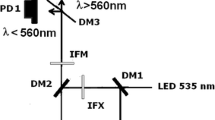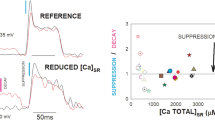Abstract
Thapsigargin has been reported to inhibit ATP-dependent Ca2+ uptake by isolated sarcoplasmic reticulum (SR) vesicles of vertebrate skeletal muscle fibres at nanomolar concentrations. There have been no reports confirming this effect in skinned muscle fibre preparations. We have examined the ability of thapsigargin to inhibit the uptake of Ca2+ by the SR in mechanically skinned fibres of frog iliofibularis muscles, using the size of the caffeine-induced contracture to assess the Ca2+ content of the SR. The SR was first depleted of Ca2+ and then reloaded for 1 min at pCa 6.2 in the presence and absence of thapsigargin. When 5 min were allowed for diffusion, a thapsigargin concentration of at least 131 μM was required to inhibit Ca2+ loading by 50%. In contrast, another SR Ca2+ uptake inhibitor, cyclopiazonic acid, was more effective, producing 50% inhibition at 7.0 μM and total inhibition at 50 μM. When cyclopiazonic acid (100 μM) was applied after, rather than during, Ca2+ loading, the caffeine-induced contracture was not changed. Thapsigargin (300 μM), on the other hand, caused some reduction in the peak amplitude of the caffeine-induced contracture when applied after Ca2+ loading. The poor effectiveness of thapsigargin in the skinned fibres, compared with in SR vesicles, is attributed to its slow diffusion into the skinned fibres, perhaps as a result of binding to myofibrillar components.
Similar content being viewed by others
References
Ashley CC, Ellory JC, Griffiths PJ (1977) Caffeine and the contractility of single muscle fibres from the barnacle Balanus nubilus. J Physiol (Lond) 269:421–439
Bassani JWM, Bassani RA, Bers DM (1993) Twitch-dependent SR Ca accumulation and release in rabbit ventricular myocytes. Am J Physiol 265:C533-C540
Baudet S, Shaoulian R, Bers DM (1993) Effects of thapsigargin and cyclopiazonic acid on twitch force and SR Ca content of rabbit ventricular muscle. Biophys J 64: A40
Claflin DR, Stephenson DG, Morgan DL, Julian FJ (1994) The early phase of the decline of the intracellular Ca2+ transient in frog skeletal muscle is not affected by thapsigargin. Biophys J 66: A301
Crank J (1975) The mathematics of diffusion. Oxford University Press, London
Dux L (1993) Muscle relaxation and sarcoplasmic reticulum function in different muscle types. Rev Physiol Biochem Pharmacol 122:69–148
Endo M (1977) Calcium release from the sarcoplasmic reticulum. Physiol Rev 57: 71–108
Favero TG, Abramson JJ (1994) Thapsigargin-induced Ca2+ release from sarcoplasmic reticulum and asolectin vesicles. Cell Calcium 15:183–189
Horiuti K (1986) Some properties of the contractile system and sarcoplasmic reticulum of skinned slow fibres from Xenopus muscle. J Physiol (Lond) 373:1–23
Hove-Madsen L, Bers DM (1993) SR Ca uptake and thapsigargin sensitivity in permeabilised rabbit and rat ventricular myocytes. Circ Res 73: 820–828
Huchet-Cadiou C, Leoty C (1993) Sarcoplasmic reticulum function in ferret cremaster skeletal muscle: effect of cyclopiazonic acid Proc XXXII Congress (Glasgow), Int Union Physiol Sci, abstract 247.12P (Wed p 71)
Janczewski AM, Lakatta EG (1993) Thapsigargin inhibits Ca2+ uptake, and Ca2+ depletes sarcoplasmic reticulum in intact cardiac myocytes. Am J Physiol 265: H517-H522
Kijima Y, Ogunbunmi E, Fleischer S (1991) Drug action of thapsigargin on the Ca2+ pump protein of sarcoplasmic reticulum. J Biol Chem 266: 22912–22918
Kirby MS, Sugara Y, Gaa S, Inesi G, Lederer WJ, Rogers TB (1992) Thapsigargin inhibits contraction and Ca2+ transient in cardiac cells by specific inhibition of the sarcoplasmic reticulum Ca2+ pump. J Biol Chem 267: 12545–12551
Kurebayashi N, Ogawa Y (1991) Discrimination of Ca2+-ATPase activity of the sarcoplasmic reticulum from actomyosin-type ATPase activity of myofibrils in skinned mammalian skeletal muscle fibres: distinct effects of cyclopiazonic acid on the two ATPase activities. J Muscle Res Cell Motil 12: 355–365
Lamb GD, Stephenson DG (1990) Calcium release in skinned muscle fibres of the toad by transverse tubule depolarization or by direct stimulation. J Physiol (Lond) 423: 495–517
Lamb GD, Stephenson DG (1990) Control of calcium release and the effect of ryanodine in skinned muscle fibres of the toad. J Physiol (Lond) 423: 519–542
Lea TJ (1986) A comparison of the abilities of CO2/HCO3 −, protonophores and changes in solution pH to release Ca2+ from the SR of barnacle myofibrillar bundles. Pflugers Arch 406: 315–322
Lytton J, Westlin M, Hanley MR (1991) Thapsigargin inhibits the sarcoplasmic reticulum and endoplasmic reticulum Ca-ATPase family of calcium pumps. J Biol Chem 266: 17067–17071
Perrin DD, Sayce IG (1967) Computer calculations of equilibrium concentrations in mixtures of metal ions and complexing species. Talanta 14: 833–842
Sagara Y, Inesi G (1991) Inhibition of the sarcoplasmic reticulum transport ATPase by thapsigargin at subnanomolar concentrations. J Biol Chem 266: 13503–13506
Seidler NW, Jona I, Vegh M, Martonosi A (1989) Cyclopiazonic acid is a specific inhibitor of the Ca2+-ATPase of sarcoplasmic reticulum. J Biol Chem 264: 17816–17823
Stephenson DG, Wendt IR, Forrest QG (1981) Non-uniform ion distributions and electrical potentials in sarcoplasmic regions of skeletal muscle fibres. Nature 289: 690–692
Thastrup O, Cullen PJ, Drobak BK, Hanley MR, Dawson AP (1990) Thapsigargin, a tumor promoter, discharges intracellular Ca2+ stores by specific inhibition of the endoplasmic reticulum Ca2+-ATPase. Proc Natl Acad Sci USA 87: 2466–2470
Timmerman MP, Ashley CC (1986) Fura-2 diffusion and its use as an indicator of transient free calcium changes in single striated muscle cells. FEBS Lett 209: 1–8
Vilsen B, Andersen JP (1992) Deduced amino acid sequence and E1-E2 equilibrium of the sarcoplasmic reticulum Ca2+-ATPase of frog skeletal muscle. FEBS Lett 306: 213–218
Wahr PA, Johnson JD, Rall JA (1993) The role of the sarcoplasmic reticulum (SR) in frog skeletal muscle relaxation Proc XXXII Congress (Glasgow), Int Union Physiol Sci abstract 30.9/0 (Sun p 49)
Wictome M, Michelangeli F, Lee AG, East JM (1992) The inhibitors thapsigargin and 2,5-di(tert-butyl)-1,4-benzohydroquinone favour the E2 form of the Ca2+, Mg2+-ATPase. FEBS Lett 304: 109–113
Author information
Authors and Affiliations
Rights and permissions
About this article
Cite this article
Du, G.G., Ashley, C.C. & Lea, T.J. Effects of thapsigargin and cyclopiazonic acid on the sarcoplasmic reticulum Ca2+ pump of skinned fibres from frog skeletal muscle. Pflugers Arch. 429, 169–175 (1994). https://doi.org/10.1007/BF00374309
Received:
Revised:
Accepted:
Issue Date:
DOI: https://doi.org/10.1007/BF00374309




